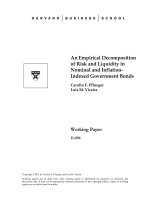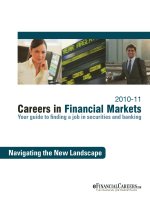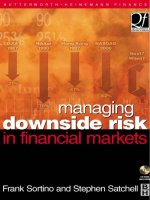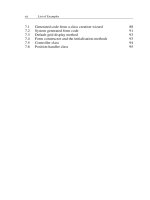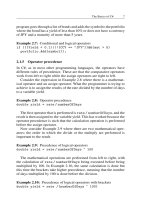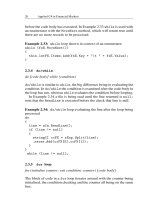Schwartz (eds ) volatility; risk and uncertainty in financial markets (2011)
Bạn đang xem bản rút gọn của tài liệu. Xem và tải ngay bản đầy đủ của tài liệu tại đây (3.62 MB, 154 trang )
Volatility
Zicklin School of Business Financial
Markets Series
Robert A. Schwartz, Editor
Baruch College/CUNY
Zicklin School of Business
New York, NY, USA
Other Books in the Series:
Schwartz, Robert A., Byrne, John A., Colaninno, Antoinette:
Technology and Regulation
Schwartz, Robert A., Byrne, John A., Colaninno, Antoinette:
Competition in a Consolidating Environment
Schwartz, Robert A., Byrne, John A., Colaninno, Antoinette:
The New NASDAQ Marketplace
Schwartz, Robert A., Byme, John A., Colaninno, Antoinette:
Electronic vs. Floor Based Trading
Schwartz, Robert A., Byrne, John A.. Colaninno, Antoinette:
Coping with Institutional Order Flow
Schwartz, Robert A., Byrne, John A.. Colaninno, Antoinette:
A Trading Desk View of Market Qualily
Schwartz, Robert A., B y r e , John A., Colaninno, Antoinette:
Call Auction Trading: New Answers to Old Questions
Schwartz, Robert A.: and Colaninno, Antoinette:
Regulation of U.S. Equity Markets
For other titles published in this series, go to
www.springer.com/series/7133
Robert A. Schwartz • John Aidan Byrne
Antoinette Colaninno
Editors
Volatility
Risk and Uncertainty in Financial Markets
Editors
Robert A. Schwartz
Department of Finance
Zicklin School of Business
Baruch College, CUNY
New York, NY
USA
John Aidan Byrne
169 Chestnut Terrace
Rockaway, NJ
USA
Antoinette Colaninno
Zicklin School of Business
Baruch College, CUNY
New York, NY
USA
ISBN 978-1-4419-1473-6
e-ISBN 978-1-4419-1474-3
DOI 10.1007/978-1-4419-1474-3
Springer New York Dordrecht Heidelberg London
© Springer Science+Business Media, LLC 2011
All rights reserved. This work may not be translated or copied in whole or in part without the
written permission of the publisher (Springer Science+Business Media, LLC, 233 Spring Street,
New York, NY 10013, USA), except for brief excerpts in connection with reviews or scholarly
analysis. Use in connection with any form of information storage and retrieval, electronic adaptation,
computer software, or by similar or dissimilar methodology now known or hereafter developed is
forbidden.
The use in this publication of trade names, trademarks, service marks, and similar terms, even if
they are not identified as such, is not to be taken as an expression of opinion as to whether or not
they are subject to proprietary rights.
Printed on acid-free paper
Springer is part of Springer Science+Business Media (www.springer.com)
Contents
List of Participants
vii
Conference Sponsors
ix
Preface
xi
Chapter 1: Intraday Volatility: The Empirical Evidence
1
Chapter 2: Opening Address: Reto Francioni
19
Chapter 3: What Is Happening With Financial Market Volatility and Why?
29
Chapter 4: Volatility and Technology
47
Chapter 5: Volatility and Market Structure
65
Chapter 6: Implications for Trading
85
Chapter 7: Closing Dialog: Sandy Frucher and Erin Burnett
99
Chapter 8: Accentuated Intraday Stock Price Volatility
111
Participant Biographies
127
List of Participants
Robert Almgren
New York University
George Bodine
Erin Burnett
Ian Domowitz
Brendan Doran
General Motors Investment
Management
Ewing Marion Kauffman
Foundation
CNBC
Investment Technology Group
Chi-X Europe Limited
Robert Engle
Stern School of Business, NYU
Reto Francioni
Sandy Frucher
William Geyer
Ken Hight
Brian Hyndman
Tim Mahoney
Terrence Martell
Deutsche Börse AG
The NASDAQ OMX Group
JonesTrading Institutional
Services, LLC
Commodity Futures Trading
Commission
Liquidnet, Inc.
The NASDAQ OMX Group
Bids Trading
Baruch College, CUNY
Albert J. Menkveld
VU University Amsterdam
Harold Bradley
Al Goll
Adjunct Professor of Mathematical
Finance
Director of Trading
Chief Investment Officer
Anchor and Reporter
Managing Director
Vice President, Business
Development
Michael Armellino Professor of
Finance, Nobel Laureate 2003
CEO
Vice Chair
CEO and President
Auditor
Head of Global Equities
Senior Vice President
CEO
Director, Weissman Center for
International Business, Saxe
Distinguished Professor of Finance
Associate Professor of Finance
List of Participants
Matt Moran
viii
Larry Tabb
Grant Vingoe
Henri Waelbroeck
Chicago Board Options
Exchange
RKA Inc.
Montclair State University
Villanova University
Rosenblatt Securities Inc.
NYSE Euronext
PDQ Enterprises, LLC
Federal Reserve Bank of New
York
FBN Securities Inc.
ICAP Electronic Broking
Baruch College, CUNY
Morgan Stanley Investment
Management
The Tabb Group
Arnold and Porter
Pipeline Trading Systems
Joseph Wald
Robert Wood
Liuren Wu
Knight Capital/EdgeTrade
University of Memphis
Baruch College, CUNY
Joe Rosen
Deniz Ozenbas
Michael Pagano
Richard Rosenblatt
James Ross
Keith Ross
Asani Sarkar
Stephen Sax
Alec Schmidt
Robert Schwartz
Robert Shapiro
Vice President
President
Associate Professor of Finance
Professor of Finance
CEO
Vice President NYSE Crossing
CEO
Economist
Vice President
Senior Analyst
Speiser Professor of Finance
Executive Director
Founder and CEO
Partner
Vice President, Director of
Research
Managing Director
Distinguished Professor of Finance
Associate Professor of Finance
Conference Sponsors
Bids Trading
Deutsche Börse AG
International Securities Exchange
Investment Technology Group
JonesTrading Institutional Services, LLC
Knight/EdgeTrade
Liquidnet, Inc.
NYSE Euronext
PDQ Enterprises, LLC
Pipeline Trading Systems
Rosenblatt Securities Inc.
The NASDAQ OMX Group
White Cap Trading LLC
Preface
Volatility and risk are of fundamental importance to the finance practitioners
among us. Indeed, volatility and risk are practically at the center of all our
work. Finance, as a subject, would not exist without them in our business
school curriculum, nor in our academic research. Simply put, finance would
be indistinguishable from deterministic economics. For that matter, the
presence of volatility and risk also bestows significant influence on the
finance departments in banks and industrial firms.
By the same token, terms like the following are part of our everyday
financial parlance: Risk aversion, risk hedging, risk management, value at
risk, risk measurement and risk premium. In our industry, we have highpowered minds, high-powered valuation formulas, high-powered trading
algorithms, and high-powered electronic technology to pull it all together.
And yet, today’s events show us what risk is really about, how at risk our
financial markets truly are. The events of the last several months also show
us how much we do not know.
Let me contrast our group with an ant, yes, that little red or black creature
that can crawl around and annoy us. An ant has actually been classified as
one of the dumbest creatures on earth! Yet, collectively, they are very
intelligent. Look at how are also highly intelligent. These are the brilliant
quants, financial engineers, entrepreneurs, academicians (if I may be so
bold), the PhD’s in chemistry, physics, and mathematics, and so on and so
forth. Finance has attracted many of the brightest minds to its ranks. Still,
collectively, as we face these bear market conditions right now, we do not
seem so smart. As a group, we have just run into a startling, frightening
hole. Are we exactly the opposite of ants? How can we individually be so
brilliant and, at the same time, collectively be so very dumb? Where are our
intelligent answers and solutions for today’s challenging markets?
xii
Volatility
There is so much about volatility and risk that we do not understand.
Even more critically, there is a substantial amount of behavior about
volatility and risk that we think we understand but, in truth, do not
understand. This kind of ignorance (mistakenly thinking we know our
subject) can really come back and bite us.
Risk isn’t the only contributor to volatility, and I believe we have lost
sight of this. Risk has a well-defined meaning to economists. Risk exists
when an outcome can be described as a draw from a probability distribution
with known parameters. Flip a fair coin and bet on the outcome: the chance
of heads equals 50%; the chance of tails equals 50%. But beyond that we do
not know the outcome until after we have flipped the coin. That is risk, clear
and simple. In this type of scenario, we will perform a decent job of
modeling risk given the probability distributions.
However, along with risk, there is also uncertainty. Here we do not know
the probability distributions. In fact, we might not even know what all of the
outcomes even are. Uncertainty presents a huge challenge. In my opinion,
we have not paid sufficient formal attention to uncertainty as a cause of
volatility.
Also high on the list of our ignorance is systemic risk and uncertainty. In
free markets individual firms will fail. Their demise may be understood in
the light of Adam Smith’s invisible hand, or of Joseph Schumpeter’s creative
destruction. Systemic risk is another matter. When a systemic breakdown
occurs, it is the free market itself that has failed.
High volatility has been with us for over a year now. In my research, I
have been focused on this topic for much longer, for many years. Now, if
you were to pick one word to describe our markets, what would that word
be? My choice would be ‘volatility.’ So let’s go for it. Let’s focus on this
key property of a financial market. I am not thinking of price fluctuations
over lengthy, multi-year periods. I do not have in mind risk and uncertainty
about the more distant future. I am thinking of the very appreciable
volatility that we experience, day after day, on an intra-day basis. In today’s
turbulent environment, intra-day volatility is dramatic.
We talk about Wall Street versus Main Street. Financial markets are
absolutely essential for the smooth functioning of our broad economy.
There is, therefore, a huge connect between Wall Street and Main Street.
Financial capital enables firms to operate, just as oil enables physical capital,
from bikes, to bulldozers, to airplanes, to run. But the financial markets are
also fragile. We do not always think about it; and in ‘normal’ times we do
not even see it. But they are fragile. This is especially so in today’s high
frequency, electronic environment, given the large pools of capital that today
can slosh anywhere around the world at a microsecond moment’s notice.
Take a look with a magnifying glass at the price movements, the swings
that take place intra-day on a daily basis. Price changes of one percent, two
Preface
xiii
percent or more are commonplace. A one percent daily price move,
annualized, translates into 250%. We do not very often see annual swings of
this magnitude. In the opening and closing seconds and minutes of trading,
intra-day price movements are even more accentuated. How come? What
explains it?
Academic evidence of accentuated daily and intra-day price volatility has
accumulated over the years. In a paper that I am currently completing with
Mike Pagano and Lin Peng, we present evidence on volatility for a large
sample of NASDAQ stocks for the year 2005. 1 It was very striking that the
three most volatile minutes in a trading day are the two minutes that follow
the open, and the final minute that precedes the close. What explains the
accentuated intra-day price volatility? Why are the financial markets so
fragile? I will briefly address two related items: price discovery and
liquidity creation.
I have been focusing on price discovery for many years. Throughout, I
have noted its importance in various publications and in my talks. The fact
is security prices – the value of shares – are not found in the upstairs offices
of the stock analysts. They are discovered in the marketplace.
Share prices are not intrinsic values. Share prices do not follow random
walks, and they are not simply and uniquely linked to ‘the fundamentals.’
How can they be when, in the face of enormously complex, imprecise, and
incomplete information, investors form diverse expectations of future
corporate performance? Thus, at any current moment, they evaluate shares
differently. And markets are not as informationally efficient as some of my
colleagues would like to think. I am not a proponent of the Efficient
Markets Hypothesis (or EMH, as we like to say). I suggest that the word
‘efficient’ be replaced. The proper adjective, in my opinion, is ‘humbling.’
The markets are indeed humbling.
Inaccurate price discovery contributes to volatility, and good price
discovery is difficult to achieve, especially when some investors’ are
influenced by what they see other investors doing. That is when we get
information cascades. That is when we get herding. That is when volatility
blows up. When these things happen, a market can run into trouble.
Arm-in-arm with price discovery is liquidity creation. I have just
completed a paper on this topic with Asani Sarkar and Nick Klagge, both
from the New York Fed. 2 In addressing the dynamic process of liquidity
creation, we consider something that we call the sidedness of markets.
1
2
Pagano, M., Peng, L., and Schwartz, R., ‘The Quality of Price Formation at Market
Openings and Closings: Evidence from the NASDAQ Stock Market.’
Klagge, N., Sarkar, A. and Schwartz, R., ‘Liquidity Begets Liquidity: Implications for a
Dark Pool Environment,’ Institutional Investor’s Guide to Global Liquidity, Winter 2009,
pp. 15-20.
xiv
Volatility
Sidedness refers to the extent to which buyers and sellers are both actively
present in a market, in roughly equal proportions, in brief periods of time
(e.g., five minute intervals).
In previous work, Asani Sarkar and I have found that markets are
generally two-sided, and that two-sidedness holds under a wide range of
conditions. 3 It holds for both NASDAQ and NYSE stocks; at market
openings, mid-day, and at the close; on days with news and on days when
there is no major news; and for both large orders and small orders. We also
observe that buyers and sellers tend to arrive in clusters, that within a day,
two-sided trading bursts are commonly interspersed with periods of relative
inactivity.
But markets are not always two-sided. At times, liquidity dries up on one
side of the market and volatility spikes. Information cascades and herding
can take over, and a market can become one-sided. Even if potential buyers
and sellers are both in the offing, neither may be making their presence
known.
And, when prices suddenly head south, one-sidedness is
accentuated as buyers simply step aside. Who wants to step up and try to
catch the falling knife?
What are the conditions that lead to two-sidedness? What are the factors
that trigger trade bursts? What causes a market to be one-sided? Illiquidity
is a cause of volatility and its counterpart, liquidity, does not just happen.
Liquidity creation is a process. There is a great deal more that we need to
learn about the process, about the dynamics of liquidity creation.
As we all know, opacity is needed by the big players. The large traders
seek the protection of opacity by either going to a dark pool or, when going
to a more transparent limit order book market, by hiding their orders in a
stream of retail flow by slicing and dicing them. Nevertheless, there is posttrade reporting for all trades, and information can be gleaned on the general
sidedness of markets.
Opacity is one thing; fragmentation is another. Whether liquidity pools
are light or dark, fragmentation can disrupt the natural two-sidedness of
markets. Can connectivity between the dark pools that exist today in the
U.S. be effective? The real concern about the dark pools of today is not that
they are dark; it is that connectivity may not be a viable substitute for
consolidation.
It is well known that order flow attracts order flow. We have also seen
that, over time, the equity markets have generally tended to consolidate.
Consolidation and two-sidedness are natural processes for an equity market.
They are the main dynamics that underlie liquidity creation. However,
modern technology facilitates the increased fragmentation of markets, and it
3
Sarkar, A. and Schwartz, R., ‘Market Sidedness: Insights into Motives for Trade Initiation,’
Journal of Finance, February 2009, pp. 375-423.
Preface
xv
supports the possibility of fragile, one-sided markets proliferating. True,
advanced technology also facilitates a greater integration of markets, but
such liquidity aggregation may prove to be inadequate. The extent to which
the natural two-sidedness of markets stays resilient in the face of these
developments remains to be seen, and the efficacy of liquidity creation hangs
in the balance..
And then there is the temporal dimension of fragmentation. I have, for a
long time, been a proponent of electronic call auction trading. I have long
urged that calls be included in our predominantly continuous trading
environment to open and to close markets. A call is an explicit price
discovery mechanism. A call amasses liquidity at specific points in time. A
call delivers price improvement for participants who place aggressive limit
orders, and this encourages them to, in fact, place aggressive limit orders.
The amassing of liquidity and the delivery of price improvement in call
auction trading means that a call is more likely to deliver a two-sided market
than its continuous market counterpart. Mike Pagano, Lin Peng and I have
done some analysis of NASDAQ’s new calls, and it appears that the calls
have achieved volatility decreases that are both substantial and statistically
significant. 4
Another market structure feature that goes to the heart of the volatility
issue is circuit breakers, or, as they are called in Germany, volatility
interruptions. In my opinion, volatility interruptions, which are brief, firmspecific trading halts, have some very desirable properties. The interruptions
are a check against order placement errors. Most importantly, they also
enable the market to switch from continuous trading to call auction trading;
in so doing, they sharpen the accuracy of price discovery.
In addition to calls, circuit breakers, and volatility interruptions, there are
other market structure solutions to the problem of extreme market
turbulence. After the crash of ’87, I proposed the establishment of voluntary
stabilization funds that would buy and sell equity shares according to a strict
and well-defined procedure. A fund could be established by a listed
company itself and run by a third-party fiduciary. In a falling market, shares
of the company’s stock would be bought by the fund and, conversely, shares
would be sold by the fund in a rising market. The fund’s buy and sell orders
would be submitted at pre-specified price points, in pre-specified amounts.
And, most importantly, these shares would be bought and sold in call auction
trading only.
This type of voluntary procedure would disrupt herding, it would bolster
the two-sidedness of markets, and it would help to curb the bouts of sharply
accentuated volatility that can occur at any time, and which have occurred in
4
Pagano, M., Peng, L., and Schwartz, R., ‘The Quality of Price Formation at Market
Openings and Closings: Evidence from the NASDAQ Stock Market.’
xvi
Volatility
full force since Labor Day 2008. My paper proposing this voluntary
procedure was published 20 years ago. 5 I still support the proposal today.
Dynamism and allocational efficiency are two powerfully positive
attributes of a free market. Instability is a free market’s Achilles heel. In the
last several months we have been hit by tidal waves of volatility. Now
fingers are being pointed at many factors, including the housing bubble,
greed, hubris, accounting rule changes, the absence of certain short-selling
restrictions, management failure, government failure, regulatory failure, and
market structure failure. In my opinion, regulatory intervention and market
structure, stand out. These two, if properly designed and implemented, could
do much to better stabilize our markets in a risky and uncertain world.
In the final analysis, it is not a matter of free markets versus regulated
markets. Regulation is indeed needed. But it must be appropriate. A better
understanding is required of the issues, concerns, and market failure realities
upon which regulations should be based. The sources of government failure
must also be taken fully into account. Excessive and ill-structured regulation
can be extremely costly to financial markets in particular, and to society at
large. I hope that, after the dust has settled, we have achieved a stronger
market structure, and a more appropriate regulatory structure. But this
much is certain: the financial turbulence of 2008 has provided us with an
abundant amount of material to think about.
Robert Schwartz
5
Schwartz, R., ‘A Proposal to Stabilize Stock Prices,’ Journal of Portfolio Management, Fall
1988, pp. 4 - 11. Translated into Italian and published in Rivista Della Borsa, August
1989. Reprinted in Journal of Trading, Volume 4, Number 2, Spring 2009, pp. 50-57.
CHAPTER 1: INTRADAY VOLATILITY: THE
EMPIRICAL EVIDENCE
Moderator: Asani Sarkar, Research Officer, Federal Reserve Bank of New York
Robert Almgren, Adjunct Professor of Mathematical Finance, New York University
Albert J. Menkveld, Associate Professor of Finance, VU University Amsterdam
Liuren Wu, Associate Professor of Finance, Baruch College, CUNY
ASANI SARKER: We now have a new forecasting tool! It is in the very
title of Bob Schwartz’s next conference (laughter). The forecast clearly
worked well for this year’s conference because, of course, it is cleverly titled
‘volatility’ – and volatility, as you all well know, is major financial news
today. Volatility is significantly present in today’s challenging markets. So,
if the title of next year’s conference is, say, ‘Negative Skewness of Returns,’
then we are really in for big trouble! However, if it is ‘Positive Skewness of
Returns,’ then we can be very happy about the future (laughter)!
Our panelists today bring distinctive points of view from their own
research on volatility and its impact on the marketplace. Bob Schwartz
talked earlier about Main Street and Wall Street. One could argue that Main
Street really only cares about macroeconomic volatility (such as the
volatility of consumption, the volatility of inflation, and the volatility of
GDP growth). But for a finance academician, what is the relationship
between financial market volatility and macroeconomic volatility? One of
the important economic stylized facts of the last 20 years is that
macroeconomic volatility has been falling on a secular basis. In other
words, volatility is secularly lower, even after adjusting for business cycles.
Macroeconomic volatility over the past 20 years is substantially lower
than over the previous 30 years. A manifestation of this is the shorter
business cycles that we observe. That is, the duration of the NBER-dated
R.A. Schwartz et al. (eds.), Volatility: Risk and Uncertainty in Financial Markets, Zicklin
School of Business Financial Markets Series, DOI 10.1007/978-1-4419-1474-3_1,
© Springer Science+Business Media, LLC 2011
1
2
Volatility
cycles are shorter. 6 This is obviously good news for consumers, businesses
and workers alike.
At the same time, we do not observe a similar decline in financial
market volatility. For example, if you take the period 1995 to early 2000,
macro-volatility was going down substantially, but the CBOE Volatility
Index, or VIX 7 (the equity market implied volatility) was actually rising
during that same period. This is a puzzle. One would think that the factors
that are causing macro-volatility to decline would have a similar affect on
financial market volatility. Yet those two measures of volatility seem to be
moving in opposite directions. Why is this the case? This is not very well
understood at this point.
One hypothesis is that financial innovation may be contributing to this.
The question is, why do we have output volatility? If you have a negative
shock (for instance, an increase in the price of oil), then a firm has to adjust
its capital structure, it has to decrease its leverage. This is difficult to do
because of various adjustment costs (for example, issuing equity financing is
costly). Therefore, the firm cannot make the adjustment easily. This leads
to a large decrease in investment and, therefore, a large decrease in output.
This is what triggers the output volatility.
Financial innovation (by this academic researchers mean things like
securitization and new forms of financing that essentially increase the
financial flexibility of firms) decreases adjustment costs. It also makes it
easier for firms to adjust their capital structures to de-leverage during bad
times. Therefore, they do not need to reduce their investment during bad
times, and so output does not go down as much. It reduces output volatility.
But financial innovation also increases financial volatility. Because the
cost of financing is lower, the quantity of financing is more sensitive to asset
pricing. So you have large fluctuations in the issuance of debt and equity.
This leads, in turn, to greater financial volatility. Interesting implications for
the current environment follow from this development.
One of the main factors in the current crisis is securitization and
structured financing. One conjecture might be that, because of all of the
problems in this market, we should expect to see reduced securitization or
reduced financial innovation, or at least an increased cost in financial
6
The National Bureau of Economic Research (NBER) is the major U.S. non-profit economic
research organization.
7
VIX is an indicator of the expected future movement of the S&P over the coming 30 days,
derived from the implied volatility premiums observed in the S&P index options market. It
is often referred to as the ‘fear index’ because investors are prepared to pay higher
premiums for option protection when more volatile markets are anticipated. This means
that, as the VIX rises higher, so does the expectation of more short-term risk by the
markets.
Chapter 1: Intraday Volatility: The Empirical Evidence
3
innovation. What implication would this have for macroeconomic volatility
and financial volatility?
Clearly, there is a lot we can focus on in this panel. So, let’s get started.
I will first ask each of the panelists to give a brief presentation. Let’s begin
with you Rob Almgren.
ROBERT ALMGREN: I am speaking from the point of view of one of
the ants that Bob Schwartz talked about. I really do not have any opinions
about whether volatility is good or bad, or about its causes. I am speaking as
an agency algorithmic trader, working for a broker-dealer 8 to execute
transactions within a day, formerly in equities and now in futures. Our
concern is not whether volatility is good or bad, or whether or not the market
should offer periodic crosses. We only care about the execution of this
transaction relative to a specific benchmark. Volatility is simply a market
property we have to measure, much as we measure the spread, the
cumulative volume, or anything else.
I will talk about the technology to do that, and, in particular, the
importance of having an intra-day measure, real-time, of volatility. You can
characterize volatility across the term structure, across time, and across
different products such as futures. (By the way, there is relatively recent
academic literature about this.) The obvious approach to measuring volatility
is to sample the price process at five-minute intervals, and then take the
standard deviation. That is your volatility. But in each of those five-minute
intervals, there may be hundreds or thousands of individual trades, or quote
updates. It is ridiculous to throw out that information in estimating the
volatility.
In particular, if you are trying to do something like steer an algorithm
that adapts its execution to real-time variations in liquidity and volatility,
then you want to know what the volatility was over the last minute, and what
it will likely be in the next minute. Was it high, or was it low? Or, should
we speed up or slow down our algorithm? You cannot do that by averaging
over time.
Here are some exhibits that show what futures markets look like. In
Exhibit 1, we see the issues that we have to deal with in futures markets. The
first problem is that futures trade almost 24 hours a day. This is a Eurodollar future: the June 2008 contract that traded on April 1st 2008. Futures
trade from about 5:00 p.m. in Chicago to 4:00 p.m. in Chicago time.
8
Dr. Almgren co-founded New York City-based Quantitative Brokers in 2008 and, at the
firm, he oversees quantitative research and analysis of best execution algorithms and
transactional cost measurement. He also maintains his academic role in mathematical
finance at New York University. Quantitative Brokers describes itself as a fully
independent and privately owned agency-only broker that specializes in execution
algorithms for U.S. interest rate futures.
Volatility
4
Close 4 PM Chicago (17:00 NY)
GEM8 price per contract
9775
9770
Open but slow overnight
9765
9760
Open 5 PM Chicago (18:00 NY)
20:00
01:00
06:00
11:00
16:00
EDT time on Tue 01 Apr 2008
Exhibit 1 A Euro-dollar future: June 2008 Contract, Traded on April 1st 2008
What we cannot see here is that, even though the market is open all night,
there is very little trading activity in the night. It is almost a 24-hour market,
but most of the activity is during the day. You want to measure volatility
that somehow filters out the overnight.
In addition, we also want to characterize what happened to the volatility
just before the New York market’s open, and just after the New York
market’s close, depending on the asset. Stock futures, for example, very
closely track the stock market over a period of time. As shown in Exhibit 2,
the data that you have to look at is very complicated if you are looking at it
in detail. If you are trying to measure volatility minute by minute, there may
be several different bid and offer prices. In equities, there are bids and offers
from many exchanges. In futures, there are bids and offers from direct
quotes and implied quotes. Direct quotes are entered specifically for the
contract traded. Implied quotes are generated as combinations of other
quotes in the market, for example, an order filled as a calendar spread plus
another contract. Then you have trade prices that bounce between the bid
and the offer. The question is, exactly what volatility are we talking about?
Remember, when you look at an overall picture like this, you are not seeing
a Brownian motion 9 by any sort of measurable definition. Nevertheless, you
9
Brownian motion (named after the Scottish botanist Robert Brown) is the seemingly random
movement of particles suspended in a fluid (i.e. a liquid or gas) or the mathematical model
used to describe such random movements. The mathematical model of Brownian motion
is a useful idealization of many real-world applications. An often quoted example is stock
market fluctuations.
Chapter 1: Intraday Volatility: The Empirical Evidence
5
still have to attach some number, which is the volatility, and you have to do
it from data like this.
GEM8 price per contract
9764.5
9764.0
9763.5
9763.0
9762.5
11:00
11:05
11:10
11:15
11:20
11:25
11:30
EDT time on Tue 01 Apr 2008
Exhibit 2 Research on Intra-Day Estimators
There are now fairly sophisticated ways to filter out the bid/offer noise.
One of the easy tricks is to use the bid and offer mid-point instead of the
trade price. With such a technique, you can update volatility minute by
minute. As shown in Exhibit 3, you can construct things like the term
structure of volatility.
40
Eurodollar volatility on April 1, 2008
Volatility (bp/day)
35
30
25
20
15
0.0
0.5
1.0
1.5
2.0
2.5
Years to maturity
Exhibit 3 Term Structure of Eurodollar Futures
3.0
6
Volatility
This is volatility across different expirations. Not surprisingly, the
volatility varies by about a factor of two from short-term futures out to
longer-term futures.
SARKAR: Professor Menkveld?
ALBERT MENKVELD: I have two points. First, I am trying to take a
more generic approach to what we should make of daily price changes in our
markets. I will decompose volatility into two components: transitory
volatility and permanent volatility. It is important to measure both
components of volatility to understand where the overall volatility is coming
from. Second, I want to make a point about algorithmic trading. I come
from Europe where we have been trading in electronic markets for some
time now – at the German stock exchange (Deutsche Börse), Euronext, and
the London Stock Exchange. Once you are able to trade electronically, the
big step is to design algorithms for electronic trading. 10 We have looked at
what this means for volatility and, in particular, what it means for liquidity.
Is the way we are now trading good or bad?
When we teach our students in a first-year class about security prices,
we assume that prices follow random walks, which means that they are
unpredictable in the short term. Today’s price for a security is equal to
yesterday’s price plus some innovation, some information that has been
impounded into the price. In this context, we do not worry about the friction
that we find in actual trading processes, nor about how securities trade in the
real world. But we should worry about this. When you consider the friction,
you realize that you do not observe equilibrium, or efficient prices. We see,
instead, the prices we trade at, the transaction prices. The mid-quotes, or
observed prices, are related to the unobserved equilibrium prices, plus a
deviation from that equilibrium price. Sometimes we trade away from what
a market-clearing or efficient price would be.
What is the reason? This has been discussed in microstructure literature
for the past three decades. One early suggestion came from the reality of our
markets – that buyers and sellers do not arrive at the same time. You might
have buyers in the morning and sellers in the afternoon, or the next day.
They may all be willing to trade at the equilibrium price, but they just arrive
at different times. If the sellers are coming in the morning and the buyers in
10
The introduction in late 2007 of the European Union’s Markets in Financial Instruments
Directive (MiFID), which more closely linked the various market centers in Europe,
further promoted the widespread usage of algorithmic trading across the continent.
According to Edhec Risk Advisory, 78 percent of European buy-side firms employed
algorithms as early as October 2006. The ability to disseminate orders at rapid speed is
one of the advantages of algorithmic, or rules-based computerized trading systems, said
Keith Bear, co-author of a report on algorithmic trading for IBM Global Business
Services, who noted that MiFID would actually make the need for fast and efficient
trading systems more urgent.
Chapter 1: Intraday Volatility: The Empirical Evidence
7
the afternoon, somebody is needed to match these order imbalances. An
intermediary must step in and absorb the buy-selling imbalance in the
market. As an intermediary, I am happy to take on that pile of securities
sold to me. But I will not be transacting at the equilibrium price. I must be
compensated for keeping that pile of securities until the afternoon, or the
next day, until the buyers come. So my bid, or the price that I am willing to
trade with you, will be much lower than the equilibrium price.
Risk bearing capital is like oil for our financial markets. 11 We need it to
match up buyers and sellers. Even within the literature of the past 30 years,
we still do not have the econometric technology to measure the size of this
risk.
I analyzed the Dow Jones Index from yesterday to develop this idea. I
took the data returns in August which are shown in Exhibit 4.
mt = mt-1 + wt (no-friction asset price dynamics)
pt = mt + Ɛt (transaction price)
Transitory (σƐ) vs. Permanent (σw) Volatility
(e.g. Grossman and Miller (1987))*
Data Returns:
a) August 0.6% vs. 1.1%
b) September 1.8% vs. 1.5%
c) October 1.2% vs. 4.7%
*Grossman, S. and M. Miller (1988), Liquidity and market structure, Journal of
Finance 43, 617-633.
Exhibit 4 Volatility – Transitory versus Permanent
I then tried to decompose their size into two components. If you look at
transaction cost prices, you see the evidence and the presence of permanent
volatility, 12 that is, the presence of prices that are permanent in nature and
11
12
For an academic perspective, Menkveld recommends, What Happened to the Quants in
August 2007? Evidence From Factors and Transaction Data. Amir Khandani,
Massachusetts Institute of Technology (MIT) and Andrew W. Lo, MIT Sloan School of
Management; National Bureau of Economic Research (NBER). October 24, 2008.
/>Menkveld, in a post-conference interview, distinguished between permanent and transitory
volatility. Transitory volatility, he noted, is associated with temporary price changes. For
example, say prices suddenly change 1 percent and then, a moment later, return and settle
back at their original, starting prices, so that the net change is, in effect, zero, that
illustrates the phenomena of temporary volatility. Permanent volatility is clearly the
Volatility
8
not temporary, like the price movements associated with transitory volatility.
I calculated it in a very simple way. Still, it conveys the idea of the two
components. It is 1.1 percent standard deviation of permanent volatility. But
to emphasize the magnitude of the distance we are trading away from the
equilibrium price, it is a substantial 60 basis points.
Let’s look at the September data returns (Exhibit 4). In that month we
see a lot more volatility. Permanent volatility is up from 1.1 percent to 1.5
percent. But look what is happening to transitory volatility, the size of the
epsilon here. That is 1.8 percent relative to 60 basis points – and that is a
total of 180 basis points. One interpretation is that risk-bearing capital at
this time was very low. Moving onto October in Exhibit 4, permanent
volatility is huge, it is almost five percent. And once again, there are the
elevated levels of transitory volatility. The point I wish to make is that
transitory volatility must be understood, for it is a very important component
of overall volatility.
I have a few words to say about algorithmic trading and electronic
markets. How does our transacting with algorithms in electronic markets
change the price dynamics? Once again, I will demonstrate the thought with
a simple equation in Exhibit 5.
mt = mt-1 + wt (no-friction asset price dynamics)
wt = ut + δqt (wt decomposition)
We add the signed transaction qt, i.e. 1 for buy order and -1
for sell order
Algorithms change the intraday price process, in particular
liquidity supply
•
•
•
they reduce δ, increase σu, quotes react to information w/o
trade arrival
adverse selection risk reduces, ergo liquidity supply
improves, more opportunity for risk-sharing trades
however, they need recurrent structure*
*Hendershott, T., Jones, C. and Menkveld A. (2008), Does Algorithmic Trading
Improve Liquidity? Journal of Finance, forthcoming.
Exhibit 5 Volatility – Algos Change Price Dynamics
The unobserved equilibrium price process is now defined in transaction
time, and in between transactions there is information. There are
opposite, occurring when prices do not systematically return to their original starting
prices.
